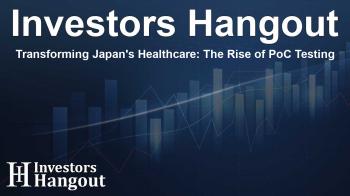Transforming Japan's Healthcare: The Rise of PoC Testing

Revolutionizing Healthcare through Point-of-Care Testing
Japan's point-of-care testing market is on an exciting trajectory, anticipated to grow significantly, reaching an estimated valuation of US$ 4,557.56 million in the coming years. This growth can largely be attributed to the increasing demands for rapid and accurate medical diagnostics, especially among the aging population. With original market size at approximately US$ 2,361.59 million, it reflects a robust compound annual growth rate (CAGR) of 7.91% between the forecast years.
The Role of an Aging Demographic
As Japan grapples with a rapidly aging society, the healthcare landscape is evolving to meet these challenges. Currently, there are around 36 million residents aged over 65, who typically require more medical attention due to the prevalence of chronic conditions like diabetes, heart failure, and respiratory diseases. Traditional lab testing methods are often slow, leading to unnecessary hospital transfers. However, modern POCT technology, such as handheld devices, provides accurate results within minutes. This capability allows healthcare providers to make real-time decisions regarding treatment during patients' visits, significantly improving patient care.
Increasing Efficiency in Hospitals
Within specialized geriatric hospitals, nurses are using POCT technologies to conduct simple tests such as creatinine and urinalysis before a specialist consultation. Such immediate testing not only streamlines the healthcare process but also reduces errors in treatment. The increased reliance on these diagnostics also aligns with global trends observed in POCT where diagnostic devices are swiftly becoming integral to healthcare.
Expansion of Point-of-Care Diagnostics
Clinical leaders highlight that Japan’s POCT market is buoyed by the government's push toward developing a comprehensive Community-based Integrated Care System. Significant strides have been made allowing ambulance services to utilize desktop troponin analyzers at triage, thus drastically cutting down the time required to rule out heart conditions. Moreover, home-visit healthcare professionals equipped with technology for transmitting patient data instantly to physicians promote a more cohesive healthcare experience.
Demand from Family Caregivers
Notably, the demand for self-testing kits has surged among family caregivers, with online sales experiencing more than double the growth in recent years. This reflects a shifting paradigm where healthcare is becoming more personalized and accessible to individuals at home, fostering a proactive approach to health management.
The Role of Policy in Market Growth
Recent policy reforms are crucial in removing barriers to market entry and facilitating the growth of decentralized testing. One such initiative involves changes to the National Health Insurance (NHI) tariff, introducing specific codes for new testing methods, which has streamlined processes in clinical settings. The regulatory landscape has also been made easier with recent amendments to the Pharmaceutical and Medical Device Act, accelerating the approval for diagnostic testing devices.
Technological Advances Driving Innovation
Japan's point-of-care testing market is witnessing remarkable shifts from single-analyte tests to complex multiplex testing technologies. Domestic companies are collaborating with innovative tech hubs to develop devices that can assess multiple health indicators at once. Such advancements are not only helping in identifying infections but are also enabling swift treatment decisions, all within a single healthcare visit.
Integration and Interoperability
Moreover, the integration of cloud-based systems allows for seamless data exchange between labs and healthcare providers, thereby improving patient care effectiveness. Healthcare providers are equipped with tools that ensure interoperability, allowing for streamlined communication and efficacy in decision-making.
Domestic Competition in the Market
The competitive landscape is vibrant, featuring a blend of established multinational players and innovative local companies. Local companies are uniquely positioned, utilizing their intimate knowledge of the regulatory environment. For instance, Sysmex has quickly gained prominence due to their customized testing solutions designed explicitly for Japanese healthcare providers.
Strategic Developments in POCT
By adopting sophisticated connectivity features, companies are not just enhancing their products but also reshaping service delivery models in healthcare. Noteworthy is the collaboration of various hospitals and diagnostic centers, which have led to the creation of integrated systems that can manage vast amounts of healthcare data effectively.
Frequently Asked Questions
What is the future outlook of Japan's point-of-care testing market?
The market is expected to reach US$ 4,557.56 million by 2033, with a CAGR of 7.91% driven by technological advancements and an aging population.
How does point-of-care testing improve healthcare access?
It allows for immediate testing and results, facilitating quicker treatments and reducing the need for hospital transfers, especially beneficial for elderly patients.
What kind of innovations are being seen in Japan's POCT market?
Innovations include the transition from traditional single-analyte tests to advanced multiplex testing and enhanced interoperability through cloud technologies.
What impact have policy reforms had on this market?
Policy reforms have streamlined approval processes for new testing devices and facilitated decentralized testing, making diagnostics more accessible.
Who are the major players in the Japan POCT market?
Key players include domestic companies like Sysmex and multinational corporations like Abbott and Roche, each contributing different innovations to the landscape.
About The Author
Contact Thomas Cooper privately here. Or send an email with ATTN: Thomas Cooper as the subject to contact@investorshangout.com.
About Investors Hangout
Investors Hangout is a leading online stock forum for financial discussion and learning, offering a wide range of free tools and resources. It draws in traders of all levels, who exchange market knowledge, investigate trading tactics, and keep an eye on industry developments in real time. Featuring financial articles, stock message boards, quotes, charts, company profiles, and live news updates. Through cooperative learning and a wealth of informational resources, it helps users from novices creating their first portfolios to experts honing their techniques. Join Investors Hangout today: https://investorshangout.com/
The content of this article is based on factual, publicly available information and does not represent legal, financial, or investment advice. Investors Hangout does not offer financial advice, and the author is not a licensed financial advisor. Consult a qualified advisor before making any financial or investment decisions based on this article. This article should not be considered advice to purchase, sell, or hold any securities or other investments. If any of the material provided here is inaccurate, please contact us for corrections.

